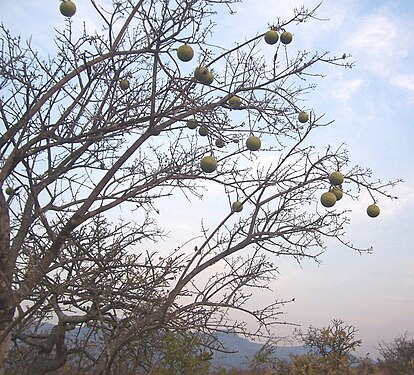Strychnos spinosa
| Habit | tree
| |
|---|---|---|
| Height: | ⇕ | 20 ft"ft" can not be assigned to a declared number type with value 20. |
| Width: | ⇔ | 12 ft"ft" can not be assigned to a declared number type with value 12. |
| Lifespan: | ⌛ | perennial |
| Bloom: | ❀ | early spring, mid spring, late spring |
| Exposure: | ☼ | sun |
|---|---|---|
| Features: | ✓ | flowers, edible, fruit |
| USDA Zones: | 10 to 12 | |
| Flower features: | ❀ | white |
|
spinosa > |
Strychnos spinosa is a tree indigenous to tropical and subtropical Africa. It produces juicy, sweet-sour, yellow fruits, containing numerous hard brown seeds. Greenish-white flowers grow in dense heads at the ends of branches (Sep-Feb/Spring - summer). The fruit tend to appear only after good rains. The smooth, hard fruit are large and green, ripen to yellow color. Inside the fruit are tightly packed seeds surrounded by a fleshy, edible covering.
Common names : Spiny Monkey-orange/Green Monkey Orange (English) Doringklapper (Afrikaans) Morapa (NS) umKwakwa (Swaziland) Nsala (Tswana) Mutamba (Shona) Maboque (Angola)
This tree can be found growing singly in well-drained soils. It is capable of growing on semi-arid and arid lands.
Read about Strychnos spinosa in the Standard Cyclopedia of Horticulture
|
|---|
|
Strychnos spinosa, Lam. Low tree: branchlets slender, armed with pungent spines from the nodes: lvs. obovate or suborbicular, 5-nerved from near the base, glabrous, subcoriaceous: cymes short, dense, terminal, very compound: fls. greenish; calyx-tube very short, segms. linear; corolla-tube short, campanulate, the lobes usually 5, ovate: fr. the size and color of an orange, the shell leathery, the pulp abundant and edible; seeds large. Trop. and S. Afr., Madagascar, and Seychelles. — A promising fr. intro. into the S. U.S. CH
|
Cultivation
Propagation
Pests and diseases
Varieties
Gallery
References
External links
- w:Strychnos spinosa. Some of the material on this page may be from Wikipedia, under the Creative Commons license.
- Strychnos spinosa QR Code (Size 50, 100, 200, 500)



